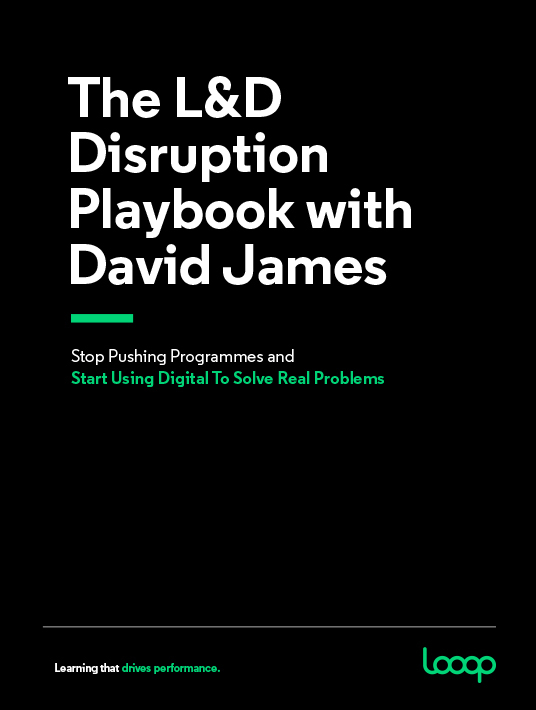How To Tell If Your Digital Learning Strategy Actually Works
We’ve mentioned the importance of developing a digital learning strategy in part 3 of this series and the importance of identifying what prevents people from efficiently doing what they need to do at work (identifying frictions) when it comes to solving real business problems.

This article is the final part of our L&D disruption blog series and dives deeper into understanding what measures need to be put into place in order to scale your digital learning strategy.
Scaling Your Digital Learning Strategy: Only Scale What Works
If you’re just looking for problems to solve with your existing tools and content, then it’s highly unlikely you’re going to see any real results. You have to start by working with your employees and understanding real business problems, and then look to scale with the right technology. Scaling what works, rather than launching platforms and content with a big bang approach, is a risk-free way of engaging larger target audiences with the value you provide them. This makes so much sense that it makes the old way look ridiculous.
The key to scaling what works is to go where there is genuine pain and a receptive audience. Don’t worry about the skeptics and those who aren’t ready yet. You’re not launching anything. You are making valuable stuff available for those who are ready for it. It’s important at this stage to bust the myth that the old way worked. Just because everybody attended a program or was assigned content at the same time doesn’t mean that people changed—or really engaged—as a result.
Old-world learning metrics may have highlighted "success." Just because somebody attended a course, stayed until the end, passed a short-term memory recall test, and rated the course 9 out of 10, doesn’t mean it made any difference to their work. Going where there is both pain and receptiveness will help you learn more about your users and their willingness to engage before you tackle the next group of people.
Digital L&D Tactics: Experiment, Test, And Act On Results
In his book, Crossing the Chasm, Geoffrey A. Moore argues there is a chasm between the early adopters of a product (enthusiasts and visionaries) and the early majority (the pragmatists).
Moore explains that visionaries and pragmatists have different expectations and suggests techniques to successfully cross the "chasm." These techniques include choosing a target market, understanding the whole product concept, positioning the product, building a marketing strategy, choosing the most appropriate distribution channel, and pricing. If you have been working with your target group, testing your prototype solution(s) and it’s produced the desired results, you’ll want to appeal to those who will be ready next.
There’s no mystery to this, and simple tactics will help you do it.
- Ask for more volunteers to be involved in the experiment
- Ask the current test group to recommend the experiment to peers
- Produce case studies of your results in order to circulate them to the rest of your target group
- Make the solution available to the rest of the target group and see what happens
And, what do you do if you get no more interest? Find out why! It’s all an experiment.
Automation Means Doing More With Less
So far, this might seem like a lot of extra work but the promise of digital is doing more with less, and this is where automation comes in and releases you from the old way of doing things. In so many parts of our lives, digital technologies have made things faster, easier, better, and cheaper—except in L&D. Automation is a way to halt this and run individual campaigns as a series of "experiences" designed to sweep users up, potentially before they even join your organization, through induction, probation, advanced technical know-how, core skill-building, ad-hoc changes, transitions into new roles, and beyond.
Progressive, AI-enhanced technologies, such as Looop, allow you to create seamless user journeys for distinct employee groups from the moment they agree to their offer to the moment they might leave. Not only does this eliminate huge amounts of administration, but it also brings your valuable resources, conversations, and courses directly to your clients, when and where they need them, which is more often in the flow of their daily work. This frees up L&D to be involved in more high-value activities to increase the impact of the function across a larger part of the organization.
Initiating Your Own Positive L&D Disruption
With digital transforming consumer experiences across every facet of our daily lives, it’s hard to imagine that it will not have the same effect on performance and productivity. The technology tools L&D has used to this point have been for the benefit of L&D in its pursuit of better learning. But digital, in this context, will not help us make better "learning." Instead, it will help harness the collective intelligence and know-how of an organization for the benefit of everybody within it.
Digital will empower individuals, not just scale programs. It will enable smarter, collective decision-making, and more reliable "doing." After all, we are all rewarded, in our professional lives by what we do, rather than what we "learn."
This is not to say that learning is not important. It is vital for individuals, organizations, and economies to thrive. However, we must recognize that the most valuable learning happens whilst doing the work, being involved, and having the confidence to try. Your digital learning strategy will be focused on supporting and guiding confident and competent "doing" at the moment it is required, by addressing friction experienced by employees.
Read more in your copy of the L&D Disruption Playbook.
The execution of your digital learning strategy will have you experiment in order to find the right tools and approaches so that digital technology can do the hard work for you. And then we, as L&D, will realize the promise of technology: to make things easier, faster, better, and cheaper and, finally, we can rise above the administration of our roles and realize our potential too.
Originally published at www.looop.co.

